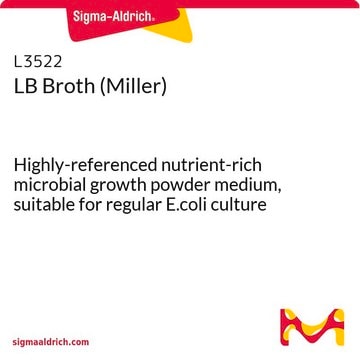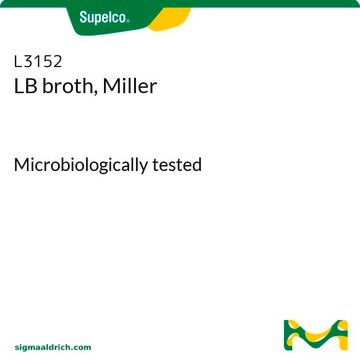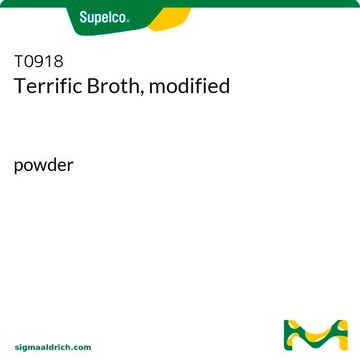L3022
LB Broth (Lennox)
Highly-referenced microbial growth powder medium, low salt, suitable for salt-sensitive E.coli culture.
Synonym(s):
Lennox broth, Lennox broth , Luria Bertani Broth
About This Item
Recommended Products
grade
for molecular biology
sterility
non-sterile
form
powder
composition
NaCl, 5 g/L
Tryptone, 10 g/L
Yeast Extract, 5 g/L
technique(s)
microbiological culture: suitable
pH
6.8-7.2(2% solution)
application(s)
food and beverages
microbiology
storage temp.
room temp
suitability
nonselective for Escherichia coli
nonselective for coliforms
General description
Application
It was used for resuspension of T. pyriformis cell fractions in a study of Trimastix fractionation of cellular extracts.
Features and Benefits
- Convenient small package to eliminate weighing
- Easy scale-up using larger package sizes
- A budget-friendly alternative to liquid
- Standard formulation
Preparation Note
2. Autoclave for 15 minutes at 121 °C.
To prepare Lennox L Broth: Add 1 g glucose and proceed with preparation instructions as above.
To prepare the medium of Enquist and Sternberg: Aseptically add 10 ml of sterile 1 M magnesium sulfate after autoclaving.
Legal Information
related product
replaced by
Storage Class Code
11 - Combustible Solids
WGK
WGK 3
Flash Point(F)
Not applicable
Flash Point(C)
Not applicable
Personal Protective Equipment
Certificates of Analysis (COA)
Search for Certificates of Analysis (COA) by entering the products Lot/Batch Number. Lot and Batch Numbers can be found on a product’s label following the words ‘Lot’ or ‘Batch’.
Already Own This Product?
Find documentation for the products that you have recently purchased in the Document Library.
Customers Also Viewed
Protocols
General protocols for growth of competent cells in microbial medium.
Our team of scientists has experience in all areas of research including Life Science, Material Science, Chemical Synthesis, Chromatography, Analytical and many others.
Contact Technical Service













